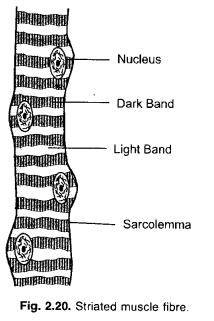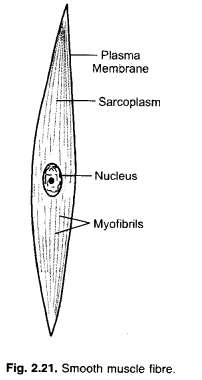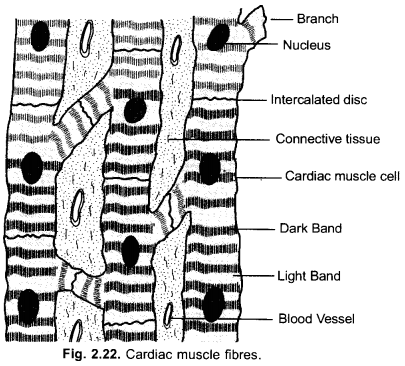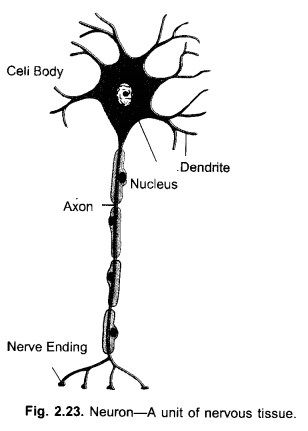NCERT Solutions for Class-9 Science Chapter-6 Tissues
NCERT TEXTBOOK QUESTIONS
Question 1. What is a tissue ?
Answer: Tissue is a group of related cells that have a common origin and perform a common function.
Answer:
1. Division of Labour: Tissues bring about division of labour in multicellular organisms. It increases efficiency.
2. Higher Organisation: Tissues become organised to form organs and organ systems.
3. Individual Cells: Work load of individual cells has decreased.
4. Higher Survival: Because of division of labour, higher efficiency and organisation, the multicellular organisms have high survival.
Question 3. Name types of simple tissues.
Answer: Three - parenchyma, collenchyma and sclerenchyma. (Meristematic tissue is also a simple tissue).
Question 4. Where is apical meristem found ?
Answer: Apical meristem occurs at root and stem tips.
Question 5. Which tissue makes up the husk of coconut ?
Answer: Sclerenchyma.
Question 6. What are the constituents of phloem ?
Answer: Sieve tubes, companion cells, phloem parenchyma and phloem fibres.
Question 7. Name the tissue responsible for movement of our body.
Answer: Muscular tissue.
Question 8. What does a neuron look-like ?
Answer: A miniature tree with thin hair like parts arising from its ends.
Answer:
1. Cells/Fibres: They are small, cylindrical, uninucleate striated with short lateral branches.
2. Intercalated Discs: In the area of union becween the two adjacent cardiac muscle fibres, zig-zag junctions called intercalated discs develop. The intercalated discs function as impulse boosters.
3. Rhythmic Contractions: The muscles are involuntary and nonfatigued which continue to contract and relax tirelessly throughout life.
Answer:
1. Packing: Areolar tissue provides packing material in various organs.
2. Binding: It binds various structures with one another in such a way as to prevent their dislocation while allowing Macrophage limited movement.
3. Covering: It provides covering over nerves, muscles and blood vessels.
4. Repair: The tissue provides materials for repair of injury.
NCERT EXERCISE
Question 1. Define the term “tissue”.
Answer: Tissue is a group of related cells that have a common origin and perform a common function.
Question 2. How many types of elements together make up the xylem tissue ? Name them.
Answer: Xylem tissue is formed of four types of elements. They are tracheids, vessels, xylem parenchyma and xylem fibres.
Question 3. How are simple tissues different from complex tissues in plants ? (CCE 2014)
Answer:
Differences between Simple and Complex Tissues
| Simple Tissues | Complex Tissues |
| 1. Cells: A simple tissue is formed of only one type of cells. | A complex tissue is made of more than one type of cells. |
| 2. Activity: All the cells perform the same function. | The different cells perform different fractions of a function. |
| 3. Types: There are three types of simple plant tissues - parenchyma, collenchyma and sclerenchyma. | There are two types of complex plant tissues— xylem and phloem. |
| 4. Function: They form primary structure of the plant. | They form transport system of the plant. |
Question 4. Differentiate amongst parenchyma, collenchyma and sclerenchyma on the basis of the cell wall.
Answer:
| Parenchyma | Collenchyma | Sclerenchyma |
1. Thickness: The cell wall is thin. 2. Smoothness: It is smooth. 3. Nature: Wall is formed of cellulose. | It is thickened. It is unevenly thickened. The thickening is pectocellulosic. | It is thickened. The wall is uniformly thickened. The thickening is generally of lignin. |
Answer: Functions of Stomata:
1. Gaseous Exchange: Stomata are sites where exchange of gases (carbon dioxide and oxygen) occurs between the plant interior and external environment.
2. Transpiration: Major part of transpiration occurs through stomata. Transpiration removes excess water and keeps plant surfaces cool even in bright sun.
3. Regulation: They regulate both gaseous exchange and transpiration.
Question 6. Diagramatically show the difference amongst three types of muscle fibres. (CCE 2014)
Answer:


Question 7. What is the specific function of cardiac muscle ?
Answer: Rhythmic contraction and relaxation continuously throughout life without getting fatigued.
Question 8. Differentiate amongst striated, unstriated and cardiac muscles on the basis of their structure and site/ location in the body.
Answer:
Striated Muscle Fibres | Smooth Muscle Fibres | Cardiac Muscle Fibres |
| 1. Cells: They are long cylindrical cells. | The fibres are elongated and spindleshaped. | The cells are small and cylindrical. |
| 2. Ends: The fibres have blunt ends. | The fibres have pointed ends. | The fibres have broad ends. |
| 3. Striations: They possess striations | Striations or light and dark bands | Striations are present but they are |
| or alternate light and dark bands. | are absent. | fainter than those of striated muscle fibres. |
| 4. Intercalated Discs and Cross | Intercalated discs and cross- | Intercalated discs and cross- |
| Connections. They are absent. | connections are absent. | connections are present. |
| 5. Nucleus: The muscle fibre is | Smooth muscle fibre is uninucleate. | The cells are uninucleate. Nucleus |
| multinucleate. Nuclei are oval in | Nucleus is centrally placed, oval or | in oval-rounded. It is centrally |
| outline. They occur peripherally below the sarcolemma. | elongated. | placed. |
| 6. Arrangement: They occur in bundles. | They generally form sheets. | They form a network. |
Question 9. Draw a labelled diagram of a neuron. (CCE 2013)
Answer:
Question 10. Name the following :
(a) Tissue that forms the inner lining of our mouth,
(b) Tissue that connects muscle to bone in humans.
(c) Tissue that transports food in plants.
(d) Tissue that stores fat in our body.
(e) Connective tissue with a fluid matrix.
(f) Tissue present in the brain.
Answer:
(a) Epithelial tissue
(b) Tendon
(c) Phloem
(d) Adipose
(e) Blood
(f) Nervous tissue.
Question 11. Identify the types of tissue in the following : skin, bark of tree, bone, lining of kidney tubule, vascular bundle.
Answer:
(a) Skin - Epithelial tissue
(b) Bark of Tree - Cork (Protective tissue)
(c) Bone - Connective tissue with solid matrix
(d) Lining of Kidney Tubule - Epithelial tissue
(e) Vascular Bundle - Complex or vascular tissues, xylem and phloem.
Question 12. Name the regions in which parenchyma tissue is present.
Answer: It occurs in almost all nonwoody parts of the plants— cortex, pith, medullary rays of stem, cortex and pith of root, chlorenchyma of leaves, flowers, pith of fruits, etc. Epidermis is special type of parenchyma.
Answer:
1. Protection,
2. Regulation of transpiration,
3. Formation of insulating stationary air layer with the help of hair,
4. Exchange of gases.
Question 14. Flow does the cork act as a protective tissue ?
Answer: Cork acts as a protective layer because its cells are dead, filled with tannins, resin and air, impermeable due to deposition of suberin over the cell walls and absence of intercellular spaces. It is insulating (heat proof), fire proof, shock proof, water proof and repellent to microbes and animals.
Question 15. Complete the table :
Answer:
(i) Parenchyma
(ii) Sclerenchyma
(iii) Phloem.

0 comment
Post a Comment